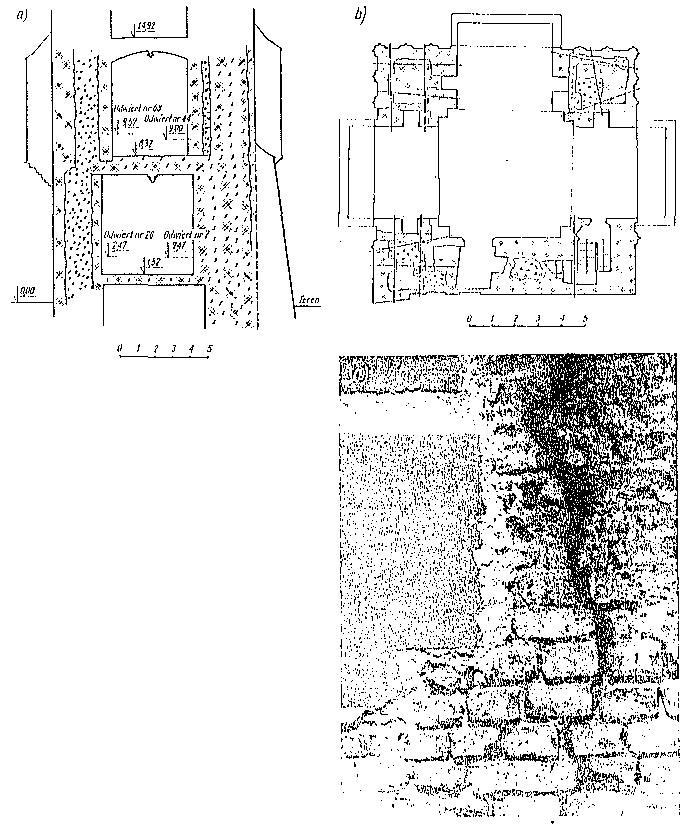Studies have shown the harmful effects of vibrations and shocks on these objects, the more that they were seriously neglected in terms of technical condition, especially the town hall tower, which had numerous cracks and weakening of the elements. It must be noted, that the introduced parameters in the scale of the impact of vibrations and shocks classified this building to a group of these buildings, which, in the absence of resistance to dynamic action, can quickly undergo further serious destruction.
As part of the measures taken, all heavy vehicles were removed from the Market in the first place, including bus transportation. In turn, in order to weaken the power of vibrations in the future, the surface of stone paving was changed, the so-called "cat's heads", marked by extreme inequality, on a vibration-damping surface with an asphalt cover. Part of the Market Square, out of motion, was covered with smooth stone slabs.
The conservation project of the town hall tower provided for the restoration of its interiors in a character corresponding to the time of their construction. On the basis of research related to the stratification of the building, it can be stated, that it was built at the turn of the 13th and 14th centuries. The building is now approx. 70,0 m, It is founded on an almost square plan with the dimensions of the sides 11,40 i 11,25 m. In the underground part, stuck approx. 6,0 m in the ground, it has massive walls made of wild-bound stone. The ground floor and upper parts are made of stone blocks and bricks. In the horizontal section of the first and second floors, the tower forms a system supported by four corner pillars, of which the cross-section of the first floor pillar on the north-western side is weakened by the staircase running through its interior.
 Town hall tower in Krakow. Cross-sections through the load-bearing pillars after removing the 18th-century casing.: a) vertical section, b) horizontal section with structure, c) typical cracking of masonry as a result of fire.
Town hall tower in Krakow. Cross-sections through the load-bearing pillars after removing the 18th-century casing.: a) vertical section, b) horizontal section with structure, c) typical cracking of masonry as a result of fire.
As shown by the measurement inventory and survey of the monument, on the first floor there used to be a spacious room with an interior opening with three arcades to the east, south and west. This room was closed with three bay windows integrally connected with the interior. The room on the second floor, height approx. 8,0 m, had large openings, later rebuilt,
In its rich history, the tower has gone through various vicissitudes. From the construction point of view, the level of its technical condition was very adversely affected by its partial reconstruction and several fires, of which the fire in 1680 r. Already at the end of the 16th century. the openings of the second floor have been bricked up. After the fire in 1680 r. the construction was so weakened, that it was decided to strengthen it from the west side with a escarpment, and the pillars to be built from the inside. At the same time, the foundations of the tower were built, and after the renovation in 1685 r. a new baroque helmet was put on. At the end of the 18th century, the body of the tower was renovated again. The research have shown, that the work was very superficial and did not contribute to strengthening the building.
As previously mentioned, dynamic tests of the structure showed its insufficient preparation for operation in the event of tremors, despite the fact that the masses of walls introduced in the 16th century, The 17th and 18th centuries seriously increased its weight.
Because the reconstruction of the interior of the ground floor, the first and second floors required the removal of layers, in the light of the above comments regarding the technical condition of the building, the problem of strengthening became very complicated, because the removal of masonry masses from the above-ground storeys worsened the conditions of dynamic stability of the building, as well as its general static and strength condition. This problem was further complicated by the disclosure of the structural features of the corner pillars. Each pillar had a different shape in individual sections: from the outside, the pillars were covered with limestone blocks or bricks, from the inside - filled with crumbs of brick and stone, but not always bound with mortar. Studies have also shown, that the body of the tower is tilted from the vertical towards the west by approx. 55 cm, a cavern in the ground was found under the escarpment.